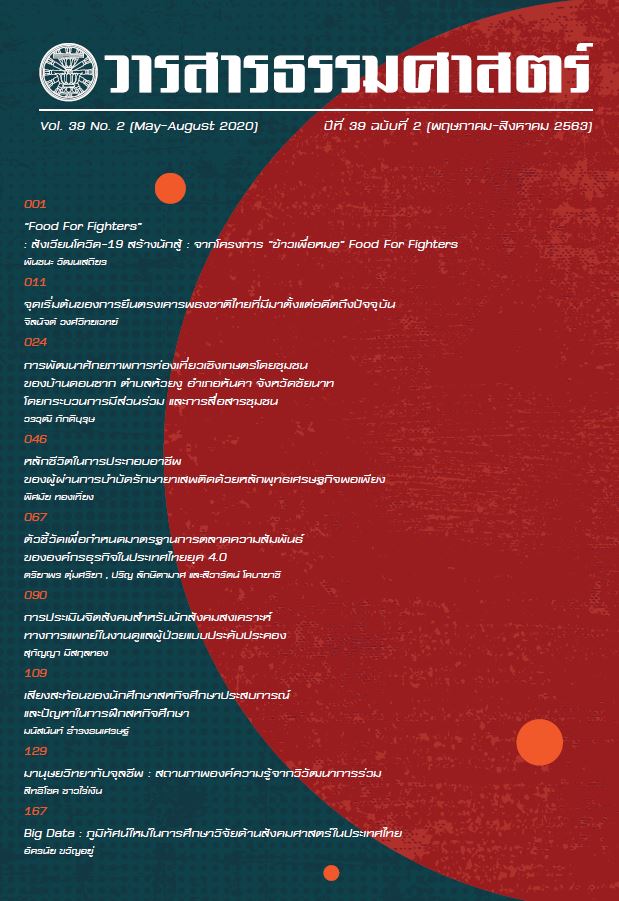The Specified Standard Indicators of Relationship Marketing for Business Enterprises in Thailand 4.0
Main Article Content
Abstract
The research aimed to study (1) the developing relationship marketing of business enterprises in Thailand 4.0 and (2) setting the standard indicators for business enterprises in Thailand 4.0. The questionnaires were constructed as a research tool for collecting data from 660 business enterprises registered in the stock exchange of Thailand and the data was statistically analyzed with frequency distribution, percentage, mean, standard deviation and Confirmatory Factor Analysis: CFA.
The research findings indicated that the sample group of business enterprises created relationship marketing in Thailand 4.0 overall at high level (ˉx =3.75) with creative potentiality, enterprising market communication, imaged enterprise and societal responsibility, marketing ethics, personnel management, business performance and business success, services and business brand respectively. The specified standard indicators of relationship marketing for business enterprises in Thailand 4.0 developed parallel with the empirical data, consisted of 44 indicators from 8 components. Each component had its convergent validity because the constructed validity valued passed more than 0.60 and extract validity of constructed reliability valued passed more than 0.50. Furthermore, all the developed indicators relationship marketing by total net marks into 5 levels of not passing standard (1 star) (<50%); below standard (2 stars); (≥50-59%) standard (3 stars) (≥60-69%); good of standard (4 stars) (≥70-89%) and excellent (5 stars) (≥90-100%)
Article Details
References
กรมพัฒนาธุรกิจการค้า. (2562). คู่มือเกณฑ์มาตรฐานธุรกิจ. กรุงเทพฯ: กระทรวงพาณิชย์.
กัลยา วานิชย์บัญชา. (2560). การวิเคราะห์สถิติขั้นสูงด้วย SPSS for Windows (พิมพ์ครั้งที่ 12). กรุงเทพฯ: สามลดา.
โกศล ดีศีลธรรม. (2554). องค์กรทําดีเพื่อสังคม. กรุงเทพฯ: นําอักษรการพิมพ์, 10-13.
ฉัตรศิริ ปิยะพิมลสิทธิ์. (2558). ทฤษฏีการวัดและการทดสอบ. คณะศึกษาศาสตร์, มหาวิทยาลัยทักษิณ. สงขลา, 9-10.
ณรงค์ โพธิ์พฤกษานันท์. (2551). ระเบียบวิธีวิจัย. กรุงเทพฯ: เอ็กซเปอร์เน็ท, 52-60.
ตลาดหลักทรัพย์แห่งประเทศไทย. (2561). รายชื่อบริษัทที่จดทะเบียนในตลาดหลักทรัพย์แห่งประเทศไทย. สืบค้นเมื่อ 16 กรกฎาคม 2562, จาก https://www.set.or.th/th/company/ companylist.html
นงลักษณ์ วิรัชชัย. (2555). ความสัมพันธ์โครงสร้างเชิงเส้น (LISREL): สถิติวิเคราะห์สําหรับการวิจัยทางสังคมศาสตร์และพฤติกรรมศาสตร์. กรุงเทพฯ: สํานักพิมพ์แห่งจุฬาลงกรณ์มหาวิทยาลัย.
ปิยะพงศ์ เอมสําราญ และสิริภักตร์ ศิริโท. (2555). การพัฒนาภาพลักษณ์ความรับผิดชอบต่อสังคมขององค์การอย่างยั่งยืน. วารสารศึกษาศาสตร์มหาวิทยาลัยศิลปากร, 10(1), 15-28.
มนตรี พิริยะกุล. (2553). ตัวแบบเส้นทางกําลังสองน้อยที่สุดบางส่วน. การประชุมวิชาการสถิติและสถิติประยุกต์ ครั้งที่ 11 ประจําปี 2553. C-2.
ราณี อมรินทร์รัตน์. (2560). ปัจจัยความสําเร็จของการตลาดเชิงสัมพันธ์ในอุตสาหกรรมท่องเที่ยว. วารสารวิจัยและพัฒนา วไลยอลงกรณ์ในพระบรมราชูปถัมภ์ สาขามนุษยศาสตร์และสังคมศาสตร์, 12(2), 321-329.
สมคิด บางโม. (2555). การเป็นผู้ประกอบการ (Entrepreneurship). (พิมพ์ครั้งที่ 5). กรุงเทพฯ:เอสเค บุ๊คส์, 19-21.
สรณ์ จงศรีจันทร์. (2562). แบรนด์ คืออะไร. สืบค้นเมื่อ 3 มีนาคม 2562, จาก https://www.softbankthai.com/Article/Detail/1665
สํานักงานคณะกรรมการข้าราชการพลเรือน. (2560). หนังสืออิเล็กทรอนิกส์ ความคิดเชิงสร้างสรรค์. สืบค้นเมื่อ 15 มีนาคม 2562, จาก http://www.ocsc.go.th/
สุวิมล ติรกานันท์. (2550). ระเบียบวิธีวิจัยทางสังคมศาสตร์: แนวทางปฏิบัติ. กรุงเทพฯ: โรงพิมพ์จุฬาลงกรณ์มหาวิทยาลัย, 44-46.
สุวิทย์ เมษินทรีย์. (2560). แนวคิดประเทศไทย 4.0. สืบค้นเมื่อวันที่ 12 มกราคม พ ศ. 2562.แหล่งที่มา: http://planning2.mju.ac.th/goverment/20111119104835_planning/Doc_25590823143652_358135.pdf
Alrubaiee, L., & Alnazer, N. (2010). Investigate the impact of relationship marketing orientation on customer loyalty: The customer’s
perspective. International Journal of Marketing Studies, 2(1), 155-174.
Byrne, B.M. (2001). Structural equation modeling with AMOS: Basic concepts, applications, and programming, Hahwah. New Jersey: Lawrence Erlbaum Associates.
Chen, J., Batchuluun, A., & Batnasan, J. (2015). Services innovation impact to customer satisfaction and customer value enhancement in airport. Technology in Society, 43(11), 219-230
Columbus, L. (2013). Roundup of CRM forecasts and market estimates, 2012. Retrieved July 18, 2019, from http://forbes.com/sites/louiscolumbus/2012/12/04/ roundup-of-crm-forecasts-and-market-estimates-2012/
Cronbach, L.J. (2003). Essential of psychology testing. New York: Hanper Collishes.
Diamantopoulos, A., & Siguaw, J. A., (2000). Introduction to LISREL: A guide for the
uninitiated. London: SEGE Publications, Inc,.
Esteghamati, A., Zandieh, A. , Khalilzadeh, O., Meysamie, A., & Ashraf, H. (2010). Clustering of metabolic syndrome components in a Middle Eastern diabetic and non-diabetic population. Diabetol Metab Syndrome, 2: 36.
Giovanis, A., Athanasopoulou, P., & Tsoukatos, E. (2015). The role of service fairness in the service quality relationship quality customer loyalty chain: An empirical study. Journal of Service Theory and Practice, 25(6), 744-776.
Hair, J.F., Anderson, R.E., Tatham, R.L., & Black, W.C. (2010). Multivariate data analysis. (7th ed.). Upper Saddle River, NJ: Prentice Hall.
Hanninen, N., & Karjaluoto, H. (2017). The effect of marketing communication on business relationship loyalty. Journal of Marketing Intelligence & Planning, 35(4), 485-472.
Hoogland, J.J., & Boomsma, A. (1998). Robustness studies in covariance structure modeling: An overview and a meta-analysis. Sociological Methods & Research, 26(3), 329-367.
Institute for Management Education for Thailand. (2018). Business Ethics. Retrieved November 11, 2018, from http://www.imetthai.com/ethicsall.php.
Kaplan, R.S., & Norton, D.P. (2007). Using the balanced scorecard as a strategic management system. Retrieved July 18, 2019, from https://hbr.org/2007/07/using-the-balanced-scorecard-as-a-strategic-management-system.
Kelloway, E.K. (1998). Using LISREL for structural equation modeling. New Jersey: Sage Publication.
Kleiman, L.S. ( 2000) . Human resource management: A managerial tool for competitive advantage. United State: South-Western College Pub.
Kolter, P. (2010) . Marketing management. (The Millennium ed.). New Jersey: Prentice Hall.
Kotler, P., & Keller, K. (2006). Marketing management. (12th ed.). Upper Saddle River, New Jersey: Pearson Prentice Hall.
Kozlenkova, I.V., Samaha, S.A., & Palmatier, R.W. (2013). Resource-based theory in marketing. Journal of the Academy of Marketing Science, 6(4), 1-21.
Lian, S.B. (2017). The role of relationship quality on customer loyalty: The effectiveness of strategic relationship marketing. Processing of 112th
The IIER International Conference, Tokyo, Japan.
Liu, C.T., Guo, Y.M., & Lee, C.H. (2011). The effects of relationship quality and switching barrier on customer loyalty. International Journal of Information Management, 31(1), 71-79.
Moriarty, S., Michel, N., & Wells, W. (2011). Advertising and IMC principles and practice. (9th ed.). Boton: Prentice Hall.
Nagasimha, K. (2000) . Role of relationship marketing in competitive marketing strategy. Journal of Management and Marketing Research, 1-17.
Ndubisi, N.O., Chan, K.W., & Gibson, N. (2017). Supplier-customer relationship management and customer loyalty: The banking industry perspective. Journal of Enterprise Information Management, 20(2), 222-236.
Nwakanma, H., Jackson, A.S., & Burkhalter, J.N. (2007). Relationship marketing: An important tool for success in the marketplace. Journal of Business & Economics Research, 5(2), 55-64.
O’Cass, A., Song, M., & Yuan, L. (2013). Anatomy of service innovation: Introduction to the special issue. Journal of Business Research, 66(8), 1060-1062.
Silván, M. (1999). A model of adaptation to a distributed learning environment. (Progradu thesis in education). Finland: University of Jyväskylä.

